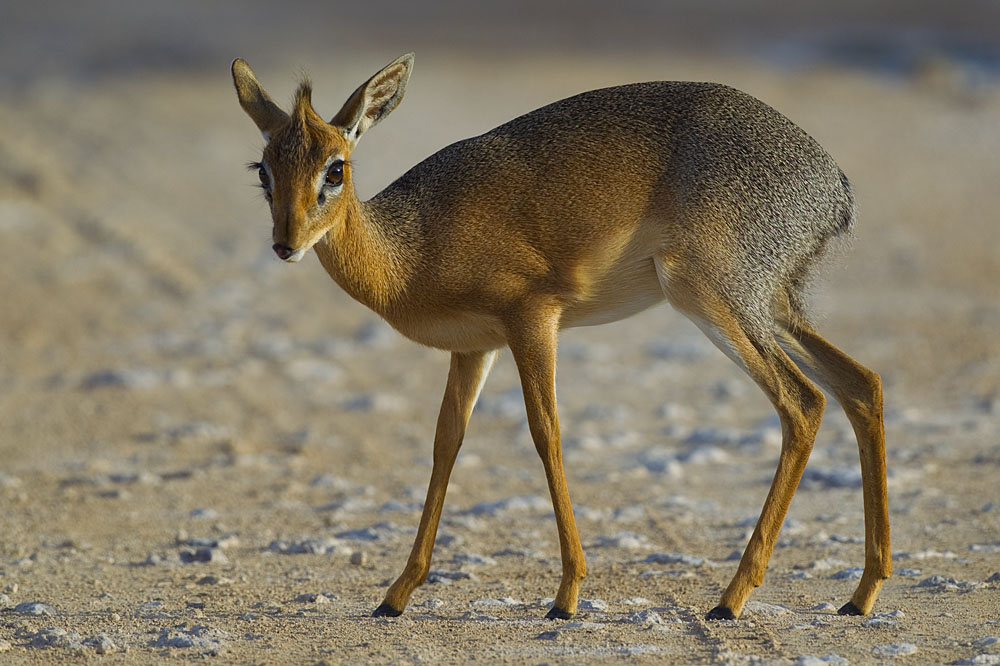The Creature Feature: 10 Fun Facts About the Dik-Dik
Dik-diks are tiny, adorable antelopes native to the grasslands of eastern and southern Africa. You can tell the sexes apart by the larger size of the females and the presence of short horns on the males. Male dik-dik horns only grow to about 3 inches long, slant backwards, and are grooved.Read on to meet the miniature, hoofed mammals with enviable eyelashes.
1. Dik-diks are tiny. Fully grown, dik-diks stand about 12-16 inches tall at the shoulders and weigh 7-15 pounds.
2. Their small size makes them easy pickings for a variety of predators. Dik-diks are hunted by big cats, jackals, monitor lizards, hyenas, wild dogs, pythons, birds of prey, and humans. They stand a chance against such predators because of their excellent eyesight and ability to reach speeds up to 26 mph.
3. Dik-diks are named for a sound they make. When alarmed, dik-diks run in a zigzag pattern and make an alarm call that sounds like "dik dik" by whistling through their noses. This shrill sound alerts other dik-diks, as well as larger animals, of nearby danger.
4. Dik-diks are one of the rare monogamous mammals. Most grazing animals live in herds, but not dik-diks: they form monogamous pairs that oversee a patch of territory. Females only give birth to one offspring at a time, up to twice a year. The baby stays with its parents until it's about seven months old, at which point the parents chase it off the family territory.
5. They mark their territory with a "defecation ceremony." First the female defecates and urinates at a specific site with the male standing directly behind her. Then he sniffs at her droppings and urine while curling his upper lip and baring his teeth. The male scrapes her feces with his front legs and deposits his own feces and urine over hers.Conflicts between neighbors are not common, but when they do occur, the males from each territory run at each other, stop short, and then nod their heads and turn around. They repeat this, starting at greater and greater distances from one another, until one gives up. Then they both paw the ground, urinate, and defecate.
6. They also mark their territory with eye secretions. A bare black spot below the inside corner of each eye contains a preorbital gland. It produces a dark, sticky secretion. Dik-diks poke their eyes in grass stems and twigs to spread the secretion, scent-marking their territories.
7. They don't have to drink. Dik-diks are herbivores whose diet mainly consists of foliage, shoots, fruit, and berries. They receive sufficient water from their food, making drinking unnecessary. They also have the most concentrated urine and driest feces of any ungulate.
8. They chew their cud. Like all even-toed ungulates, dik-diks have four-chambered stomachs and use rumination, or chewing their cud, to break down partially digested food.
9. Dik-diks have prehensile noses. Some species of dik-dik possess elongated snouts that are capable of grasping. Their noses also help in managing with the heat.
10. Dik-diks have a few strategies for dealing with the African heat. First, they sleep in shady spots during the hottest times of day. Second, they can pant to pump blood through their elongated snouts, where airflow and evaporation cool it down before it is pumped to the rest of the body.
References and Other Resources
Brotherton, P. N. M. and Manser, M. B. (1997). Female dispersion and the evolution of monogamy in the dik-dik. Animal Behaviour 54(6): 1413–1424. doi:10.1006/anbe.1997.0551.
Brotherton, P. N. M., Pemberton, J. M., Komers, P. E., and Malarky, G. (1997). Genetic and behavioural evidence of monogamy in a mammal, Kirk's dik-dik (Madoqua kirkii). Proceedings. Biological sciences/the Royal Society 264(1382): 675–681. doi:10.1098/rspb.1997.0096.
Dik-Dik. Encyclopedia of Life. Accessed June 8, 2015. at http://eol.org/data_objects/32171759Scheibe, E. (1999). Madoqua kirkii. Animal Diversity. University of Michigan Museum of Zoology. Accessed June 8, 2015.




